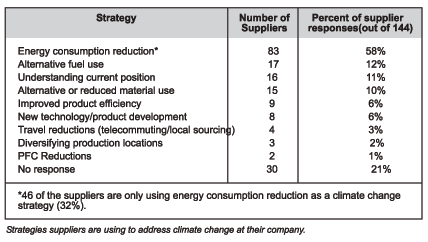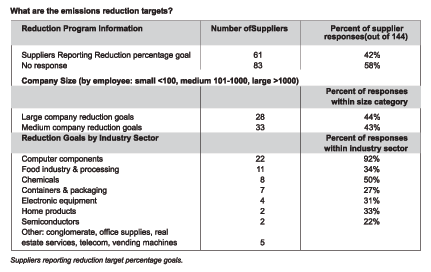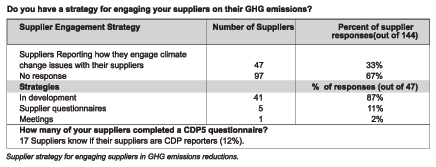The Carbon Disclosure Project’s (CDP) Supply Chain Leadership Collaboration (SCLC) is an effort to help companies better understand the climate impacts within their supply chains.
In October 2007, the CDP created the SCLC with the aim of creating a standardized process for supply chain reporting of carbon emissions, risks, opportunities and strategies. The SCLC seeks to address the increasing focus on carbon impacts of corporate supply chains, where, for many sectors, the majority of GHG emissions are generated. Corporations require better information to develop and deliver robust and effective carbon management strategies into supply chain decisions. Using the CDP process, which is the established global system for disclosing carbon emissions and related climate change issues, purchasers are now able to better understand the emissions embedded within their individual and shared supply chains.
Twelve companies (members) participated in a pilot collaboration launched in October 2007 and completed in February 2008. The SCLC Pilot Members include Cadbury Schweppes, Proctor & Gamble, Dell, PepsiCo, Hewlett-Packard, Prudential, Imperial Tobacco, Reckitt Benckiser, Tesco, Nestle and Unilever.
Survey Approach
A survey, designed by CDP in partnership with the 12 SCLC member companies, was distributed to 383 selected suppliers requesting their participation in the pilot. A striking result of the survey is that 95 out of the 144 responders submitted information to CDP for the first time demonstrating the potential of the SCLC to increase disclosure of carbon information along corporate supply chains.
Jay Celorie, Global Program Manager of Supply Chain Energy, Hewlett Packard states “The CDP Supply Chain Leadership Collaboration Pilot helped create momentum and awareness of the need for suppliers to disclose carbon within the supply chain.”
The SCLC questionnaire addressed three sections:
Section A asks suppliers for information about their overall knowledge of climate change and how it affects their company operations.
Section B asks for a detailed breakdown of emissions by country, participation in carbon emission trading schemes, a description of their reduction programme and the responsibility for climate change within the company.
Section C questions target information on companies’ supply chains and product-level detail.
To review and analyze results, CDP retained Clear Carbon Consulting, USA.
The SCLC survey is proclaimed to be a successful first step in creating a consistent approach for suppliers to report their climate change efforts to their customers and other stakeholders. The number of companies becoming a part of SCLC demonstrates that there is a growing interest from businesses to gain a better understanding of the climate impacts of their supply chain. The survey responses are useful as a baseline for members to understand the preparedness of suppliers to address climate change issues and to increase their knowledge of supply chain greenhouse gas emissions.
The SCLC is therefore an opportunity to educate a large number of additional companies on the potential risks from climate change and encourage them to measure the emissions from their operations and products and implement climate mitigation strategies.
Survey responses reveal participating companies generally have an understanding of the potential risks from climate change. Although many survey responders are still in the early stages of addressing the climate issue, they are willing to share information regarding their climate change activities and appear committed to increasing their efforts in the future.
Responding suppliers represent a variety of industries and range from small businesses (less than 100 employees) to large corporations with thousands of employees.
Overall, there is a higher response rate, 60 percent, for Section A questions (Climate Change Risk, Opportunities, and Strategy), than Section B (Additional GHG Emissions Accounting) and C (GHG Emissions Analysis), at 48 and 28 percent respectively.
The response rates reflect the typical carbon management continuum of companies. Companies generally assess risks first, perform (Greenhouse gas) emission accounting to get a detailed picture of their impacts, set targets to measure progress, and then evaluate reduction opportunities and implement projects. Once companies have a handle on the management of their internal GHG footprint, they begin to evaluate impacts and implement reduction activities along their supply chain.
Greenhouse Gas Emissions Analysis
Many suppliers indicate they are working on breaking down emissions calculations into various business segments and provide many reasons why they currently are not able get to that level of detail.
Some companies stated they produce multiple products within one facility and it would be difficult and expensive to sub-meter the entire facility to get individual product line emissions.
Others indicate resources do not exist to collect or analyze the data needed to get to that level. A majority of the respondents (68 percent) are able to breakdown emissions to the factory or facility level.
A few companies indicate the ISO 14064 – Greenhouse Gas Accounting standard only requires facility level data. And they have not gone beyond what is required in that standard.
GHG Protocol: Popular Methodology
The GHG Protocol, developed by the World Resources Institute and the World Business Council for Sustainable Development, is the international standard for how companies measure their GHG emissions. Over half of the suppliers responding to the survey (56 percent) use the GHG Protocol as their methodology to calculate corporate emissions. Other suppliers use a wide range of accounting methods including. 58 percent of the suppliers report their Scope 1 and 2 emissions. All but one of these companies is a large or medium sized supplier.
A majority of responders (65 percent) report electricity use information, something Pakistani companies are now seriously evaluating. Only 27 suppliers report renewable energy investments. There was no appreciable pattern of renewable energy investments among specific industry sectors, but large companies were responsible for 65 percent of renewable energy investments reported through the survey.
What commercial opportunities does climate change present to your company for both existing and new products and services?
Suppliers report various opportunities presented by climate change mitigation strategies. The companies list savings from energy reduction as the biggest opportunity, as is being realized by pockets of Pakistani companies as well. Suppliers also see production of energy efficient and/or new environmental products as opportunities for the future. For example, there are opportunities to produce more energy efficient computer components. Other suppliers indicated they are looking at reducing the weight of products and/or packaging to be more efficient and reduce the waste and fuel-use that impacts shipping costs.
What are your emissions reduction targets?
32 percent of the responders have set some type of reduction target and 26 percent of suppliers have emissions reduction targets in development. 29 of the 37 suppliers with targets in development are new CDP responders. This may indicate that the request to participate in the CDP encourages these companies to develop reduction targets. Responders understand that stakeholders expect them to develop a GHG reduction target as part of a credible climate strategy. The most common type of target is an absolute or intensity metric GHG emissions reductions goal. Other targets reported include carbon neutral, diesel fuel reduction and reductions from renewable energy use.
Section A – Climate Change Risks, Opportunities and Strategy

Analysis
Many companies (77 percent of respondents) see some type of GHG regulation(s) as a future risk for their company. The next most commonly reported risk is price increases in energy and raw materials (12 percent of respondents).
Responses to the two questions above show that companies have a more immediate concern about regulatory risks than physical risks (96 percent and 87 percent of respondents reported these risks). This speaks to the concern of businesses to address short-term impacts, versus less predictable and long-term impacts even though these may be on a larger scale.
The majority of suppliers have projects in place to reduce GHG emissions. Based on responses from suppliers, 58 percent of the respondent companies are engaging in energy consumption reduction programs. A table showing the strategies suppliers have in place to reduce risks and take advantage of oppor- tunities is below. Additionally, forty six companies are only pursuing strategies to reduce energy consumption, which is typically a first step in addressing GHG emissions.
Section B – Greenhouse Gas Emissions
Fifty-eight percent (58 percent) of responding suppliers have an established baseline for their GHG reduction programme. 42 percent of suppliers have no inventory to date, indicating that GHG management within the members’ supply chains is still at an early stage.
What is your company’s strategy for trading in the EU Emissions Trading Scheme?
Less than 20 percent of the suppliers participate in emissions trading schemes. They participate across a variety of programs as shown in table 11.
Which measurement best describes your company’s emissions intensity performance?
Only 26 percent of the suppliers provide emissions intensity measurements. These respondents indicate emissions per unit of production or volume of production as the two most commonly used emissions intensity metrics.
Climate Change Governance
Which Board Committee or other executive body has overall responsibility for climate change?
More than a third of the responding companies have a member of the Board of Directors responsible for climate change. Another third of the respondents report an Environment, Health, and Safety (EH&S) or Corporate Social Responsibility (CSR) committee as being responsible for climate change.
What is the mechanism by which the company reviews climate change progress?
49 percent of the suppliers report their companies review the status of their climate change initiatives through various mechanisms. Many companies integrate climate change initiatives review with their ISO 14001 management review meetings or other environmental committee meetings. Other companies indicate it as an agenda item for Board meetings. 32 companies (22 percent) have performance reviews or appraisals for their managers tied to goals set in their climate change programmes.
Section C – Disclosure in Your Supply Chain
Scope 3 Emissions
Do you track Scope 3 emissions?
Scope 3 covers all indirect emissions (other than from purchased electricity) that occur from sources that are not owned or controlled by the company.
Only 33 percent of companies surveyed report they track any Scope 3 emissions. The most commonly tracked Scope 3 emissions are business travel and distribution/logistics.
Are you able to breakdown Scope 3 emissions by any of the following categories (business division, business unit, factory, product group, product line, SKU)?
Only 10 percent of the responders can breakdown their Scope 3 emissions to some level within their company. No companies surveyed can breakdown emissions to the SKU level. About a dozen suppliers report that lack of access to data and the resources to collect and analyze data limit supplier’s ability to calculate these emission sources.
What methodology do you use to track or calculate Scope 3 emissions?
All but one of 18 respondents indicated they use internal databases – the other supplier reported using employee surveys.
While only three companies report that they have strategies in place to engage their suppliers on their GHG emissions, a surprising 41 responders indicate they have a strategy to engage suppliers in development.








